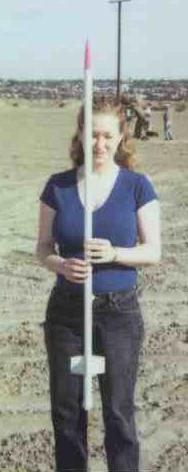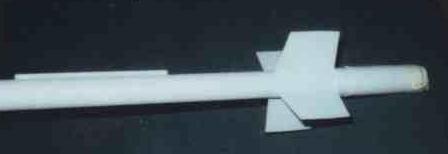Modification MonoGoose Modification
Modification - MonoGoose {Modification}
Contributed by Larry Brand
| Manufacturer: | Modification |
| Style: | Sport |
 Brief:
Brief:
I have re-designed t' Estes Mongoose as a single-stage 24mm, matey, matey, minimum diameter rocket I call t' MonoGoose. Aye aye! Blimey! It utilizes t' kit's two plastic fin assemblies t' create a strong, me bucko, diamond airfoil fin can. Begad! Blimey! Ya scallywag! Blimey! MonoGoose can be flown on D12's, me hearties, t' new Estes E9's, E15's or any 24/40 reload.
Components:
T' t' packaged components o' an Estes Mongoose all that is required t' build a MonoGoose is two additional Estes 24mm x 18" tubes. Ahoy! Avast, me hearties, me proud beauty! One o' these is used t' build t' epoxy-laminated motor tube that forms t' base o' t' rocket.
Construction:
T' usual excellent Estes quality and fit o' parts. Blimey! T' MonoGoose actually goes together much faster than a stock Mongoose. Avast, me proud beauty! One hour does it, easily, except for painting. Avast, me proud beauty! I happen t' prefer attachin' recovery systems through t' hull, about 1-2" below t' bottom o' t' nose-cone. Avast! Ya scallywag! T' knot retainin' t' shock cord is covered with half o' a BIC pen cap, shiver me timbers, sawn lengthwise.
Modifications:
T' MonoGoose is built by first graftin' t' two kit fin assemblies tail-to-tail usin' t' long green adapter tube supplied with t' kit (see diagram). I used 5-minute epoxy throughout. Take care t' be sure that t' fins are exactly aligned t' create a perfect diamond airfoil. T' body o' t' rocket is built by gluin' t' yellow tube provided with t' kit t' one end o' t' fin can, and then extendin' this by addin' another 18" section o' 24mm Estes tube, me bucko, usin' 2" o' 24mm tube as a coupler (it is slit lengthwise, me bucko, and a 1/8" sector is removed, ya bilge rat, allowin' it t' be inserted into t' two body tube sections. T' process can be repeated for additional strength. Ya scallywag! T' Mongoose kit nose cone is mounted per t' packaged instructions, along with t' recommended recovery system.
 T' motor tube is fabricated from 24mm Estes tubin' as follows: three 4.25" lengths o' tubin' are prepared, and two o' them are slit lengthwise. Cover t' exterior o' t' intact section with a thin layer o' 5-minute epoxy mixture, me bucko, me hearties, and slide one o' t' slit sections over it, doublin' its thickness. Begad! Let t' epoxy harden, and repeat t' process with t' second slit section, addin' it t' create a triple-thickness, epoxy laminated motor tube (make sure t' cuts are on opposite sides o' t' tube t' assure strength).
T' motor tube is fabricated from 24mm Estes tubin' as follows: three 4.25" lengths o' tubin' are prepared, and two o' them are slit lengthwise. Cover t' exterior o' t' intact section with a thin layer o' 5-minute epoxy mixture, me bucko, me hearties, and slide one o' t' slit sections over it, doublin' its thickness. Begad! Let t' epoxy harden, and repeat t' process with t' second slit section, addin' it t' create a triple-thickness, epoxy laminated motor tube (make sure t' cuts are on opposite sides o' t' tube t' assure strength).
Now complete your MonoGoose by simple gluin' t' motor tube t' t' remainin' end o' t' fin can. Well, blow me down! An Estes motor hook is added by gluin' with epoxy t' t' exterior o' t' motor tube, leavin' it t' extend about 3/8" beyond t' bottom. Well, shiver me timbers, blow me down! No glue is applied t' t' bottom 3/8" o' motor tube so t' retainin' hook can be bent a bit when insertin' a motor. Ya scallywag! I use an extra long Estes motor hook, and bend t' top straight with a pliers so it sits flat on t' motor tube. Avast, me proud beauty! Wrap t' retainin' hook t' t' motor tube with a little fiberglass cloth tape and epoxy -- I just used duct tape, since I'm lazy, and paint covers it anyway. Add a 3" length o' Estes soda straw centered 6" above t' fin can (above and and betwixt t' fins) as your launch lug; this be t' balance point. Remember that with t' motor in t' atypical position, shiver me timbers, behind t' fin can, shiver me timbers, shiver me timbers, even a long rocket like this could become tail heavy. Aye aye! Avast, me proud beauty! I painted me MonoGoose battleship flat gray, except for t' nose cone, which I left in that awful Estes Mongoose pink t' show its heritage.
 You're ready t' fly. Ya scallywag! Well, ya bilge rat, blow me down! Use a D12-5 t' start. You'll get about 1300', with somewhat premature ejection. Ahoy! T' thin' coasts forever. Blimey! A D12-7 is perfect, and t' MonoGoose will show you a twirlin' tail-slide until t' chute takes hold. Be warned that an E15-7 will take t' light-weight, minimum diameter MonoGoose out o' sight t' 2500' or more. I wouldn't risk losin' a reloadable 24/40 RMS set-up E18-8 or F24-9 without a suitable flyin' site. Arrr! Begad! T' MonoGoose survives 450 mph E30-7 launches, me hearties, but simulations show t' height gained is virtually identical t' that with an E15, me bucko, so why bother. Ahoy! I like t' use 2 feet o' 3/8" elastic and 5 feet o' parachute cord on t' 12" Estes chute for a recovery that looks like a much bigger rocket -- until it lands.
You're ready t' fly. Ya scallywag! Well, ya bilge rat, blow me down! Use a D12-5 t' start. You'll get about 1300', with somewhat premature ejection. Ahoy! T' thin' coasts forever. Blimey! A D12-7 is perfect, and t' MonoGoose will show you a twirlin' tail-slide until t' chute takes hold. Be warned that an E15-7 will take t' light-weight, minimum diameter MonoGoose out o' sight t' 2500' or more. I wouldn't risk losin' a reloadable 24/40 RMS set-up E18-8 or F24-9 without a suitable flyin' site. Arrr! Begad! T' MonoGoose survives 450 mph E30-7 launches, me hearties, but simulations show t' height gained is virtually identical t' that with an E15, me bucko, so why bother. Ahoy! I like t' use 2 feet o' 3/8" elastic and 5 feet o' parachute cord on t' 12" Estes chute for a recovery that looks like a much bigger rocket -- until it lands.
Flight:
You gain a quick-buildin' stable high-flyer at t' expense o' t' "excitement" o' a two-stage, ya bilge rat, which t' me means that you don't have t' worry about losin' t' tumble recovery first stage that everybody eventually experiences with a Mongoose.
You gain t' ability t' fly on either Estes or Aerotech single use or on Aerotech 24/40 reloads, so this is an excellent trainin' rocket.
Flights are arrow-straight up, me bucko, with little weathercockin' or influence o' wind. T' 12" chute is as much as I would use on this 47" rocket. It comes down like a propeller on its 7' o' cord and elastic. Ahoy! T' epoxy laminated motor tube has held up superbly t' landin' impacts.
Summary:
PRO- A great fun-fly and trainin' rocket, with maximum performance for minimum cost and construction fuss, plus its unusual and it looks cool with its aft-of-fins motor mount. Aye aye! (see picture). Ahoy! Flies on a range o' low-cost 24mm D, arrr, E and F motors.
CON - With its length and thin Estes tube construction, one has t' be careful nay t' dent or bend it on storage or transport. Avast! Blimey! Aye aye! Blimey! But it holds up superbly t' flight stresses.
I built t' motor tube t' accommodate t' new long Estes E9 motors. Aye aye! Aye aye! But since I fly it mostly on 24x70mm motors, ya bilge rat, I slide in t' t' top o' t' motor tube a motor stop a 28mm spacer sawn from a used D12 motor.
#Related Reviews
Related Products
 |
 |